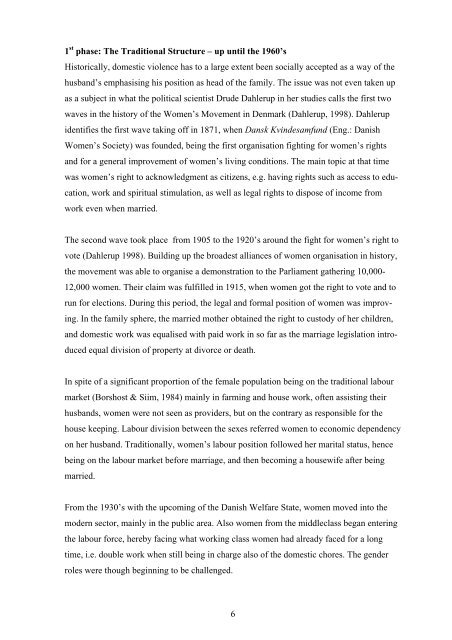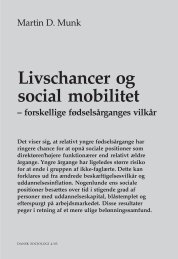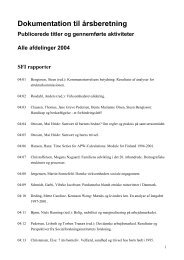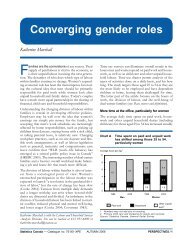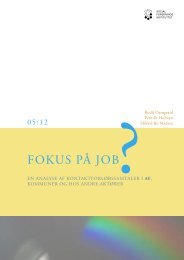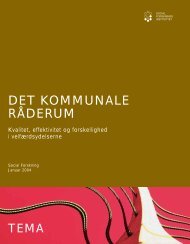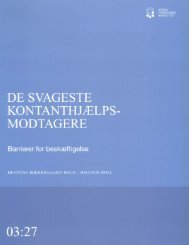Shelters in Denmark For Battered Women - European Commission
Shelters in Denmark For Battered Women - European Commission
Shelters in Denmark For Battered Women - European Commission
You also want an ePaper? Increase the reach of your titles
YUMPU automatically turns print PDFs into web optimized ePapers that Google loves.
1 st phase: The Traditional Structure – up until the 1960’s<br />
Historically, domestic violence has to a large extent been socially accepted as a way of the<br />
husband’s emphasis<strong>in</strong>g his position as head of the family. The issue was not even taken up<br />
as a subject <strong>in</strong> what the political scientist Drude Dahlerup <strong>in</strong> her studies calls the first two<br />
waves <strong>in</strong> the history of the <strong>Women</strong>’s Movement <strong>in</strong> <strong>Denmark</strong> (Dahlerup, 1998). Dahlerup<br />
identifies the first wave tak<strong>in</strong>g off <strong>in</strong> 1871, when Dansk Kv<strong>in</strong>desamfund (Eng.: Danish<br />
<strong>Women</strong>’s Society) was founded, be<strong>in</strong>g the first organisation fight<strong>in</strong>g for women’s rights<br />
and for a general improvement of women’s liv<strong>in</strong>g conditions. The ma<strong>in</strong> topic at that time<br />
was women’s right to acknowledgment as citizens, e.g. hav<strong>in</strong>g rights such as access to education,<br />
work and spiritual stimulation, as well as legal rights to dispose of <strong>in</strong>come from<br />
work even when married.<br />
The second wave took place from 1905 to the 1920’s around the fight for women’s right to<br />
vote (Dahlerup 1998). Build<strong>in</strong>g up the broadest alliances of women organisation <strong>in</strong> history,<br />
the movement was able to organise a demonstration to the Parliament gather<strong>in</strong>g 10,000-<br />
12,000 women. Their claim was fulfilled <strong>in</strong> 1915, when women got the right to vote and to<br />
run for elections. Dur<strong>in</strong>g this period, the legal and formal position of women was improv<strong>in</strong>g.<br />
In the family sphere, the married mother obta<strong>in</strong>ed the right to custody of her children,<br />
and domestic work was equalised with paid work <strong>in</strong> so far as the marriage legislation <strong>in</strong>troduced<br />
equal division of property at divorce or death.<br />
In spite of a significant proportion of the female population be<strong>in</strong>g on the traditional labour<br />
market (Borshost & Siim, 1984) ma<strong>in</strong>ly <strong>in</strong> farm<strong>in</strong>g and house work, often assist<strong>in</strong>g their<br />
husbands, women were not seen as providers, but on the contrary as responsible for the<br />
house keep<strong>in</strong>g. Labour division between the sexes referred women to economic dependency<br />
on her husband. Traditionally, women’s labour position followed her marital status, hence<br />
be<strong>in</strong>g on the labour market before marriage, and then becom<strong>in</strong>g a housewife after be<strong>in</strong>g<br />
married.<br />
From the 1930’s with the upcom<strong>in</strong>g of the Danish Welfare State, women moved <strong>in</strong>to the<br />
modern sector, ma<strong>in</strong>ly <strong>in</strong> the public area. Also women from the middleclass began enter<strong>in</strong>g<br />
the labour force, hereby fac<strong>in</strong>g what work<strong>in</strong>g class women had already faced for a long<br />
time, i.e. double work when still be<strong>in</strong>g <strong>in</strong> charge also of the domestic chores. The gender<br />
roles were though beg<strong>in</strong>n<strong>in</strong>g to be challenged.<br />
6


